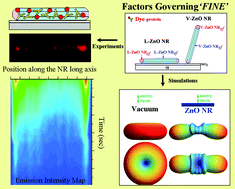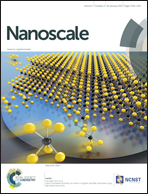Insight into factors affecting the presence, degree, and temporal stability of fluorescence intensification on ZnO nanorod ends
Abstract
We have carried out a combined experimental and simulation study identifying the key physical and optical parameters affecting the presence and degree of fluorescence intensification measured on zinc oxide nanorod (ZnO NR) ends. Previously, we reported on the highly localized, intensified, and prolonged fluorescence signal measured on the NR ends, termed fluorescence intensification on NR ends (FINE). As a step towards understanding the mechanism of FINE, the present study aims to provide insight into the unique optical phenomenon of FINE through experimental and simulation approaches and to elucidate the key factors affecting the occurrence, degree, and temporal stability of FINE. Specifically, we examined the effect of the length, width, and growth orientation of single ZnO NRs on the NR-enhanced biomolecular emission profile after decorating the NR surfaces with different amounts and types of fluorophore-coupled protein molecules. We quantitatively and qualitatively profiled the biomolecular fluorescence signal from individual ZnO NRs as a function of both position along the NR long axis and time. Regardless of the physical dimensions and growth orientations of the NRs, we confirmed the presence of FINE in all ZnO NRs tested by using a range of protein concentrations. We also showed that the manifestation of FINE is not dependent on the spectroscopic signatures of the fluorophores employed. We further observed that the degree of FINE is dependent on the length of the NR with longer NRs showing increased levels of FINE. We also demonstrated that vertically oriented NRs exhibit much stronger fluorescence intensity at the NR ends and a higher level of FINE than the laterally oriented NRs. Additionally, we employed finite-difference time-domain (FDTD) methods to understand the experimental outcomes and to promote our understanding of the mechanism of FINE. Particularly, we utilized the electrodynamic simulations to examine both near-field and far-field emission characteristics when considering various scenarios of fluorophore locations, polarizations, spectroscopic characteristics, and NR dimensions. Our efforts may provide deeper insight into the unique optical phenomenon of FINE and further be beneficial to highly miniaturized biodetection favoring the use of single ZnO NRs in low-volume and high-throughput protein assays.


 Please wait while we load your content...
Please wait while we load your content...